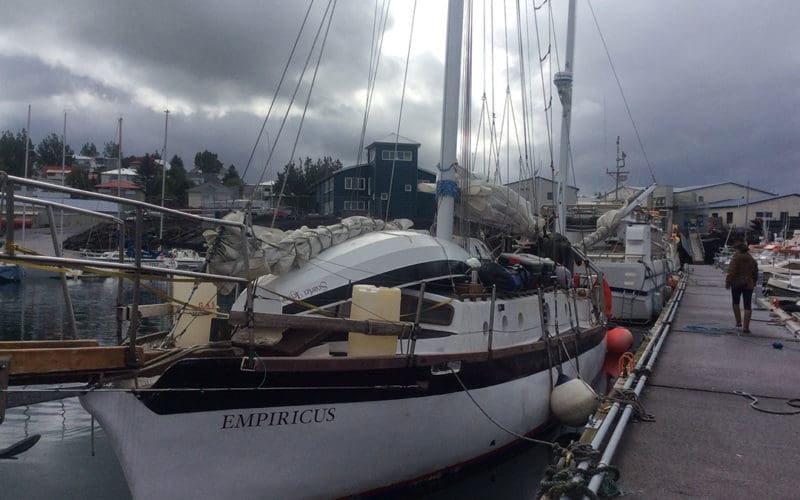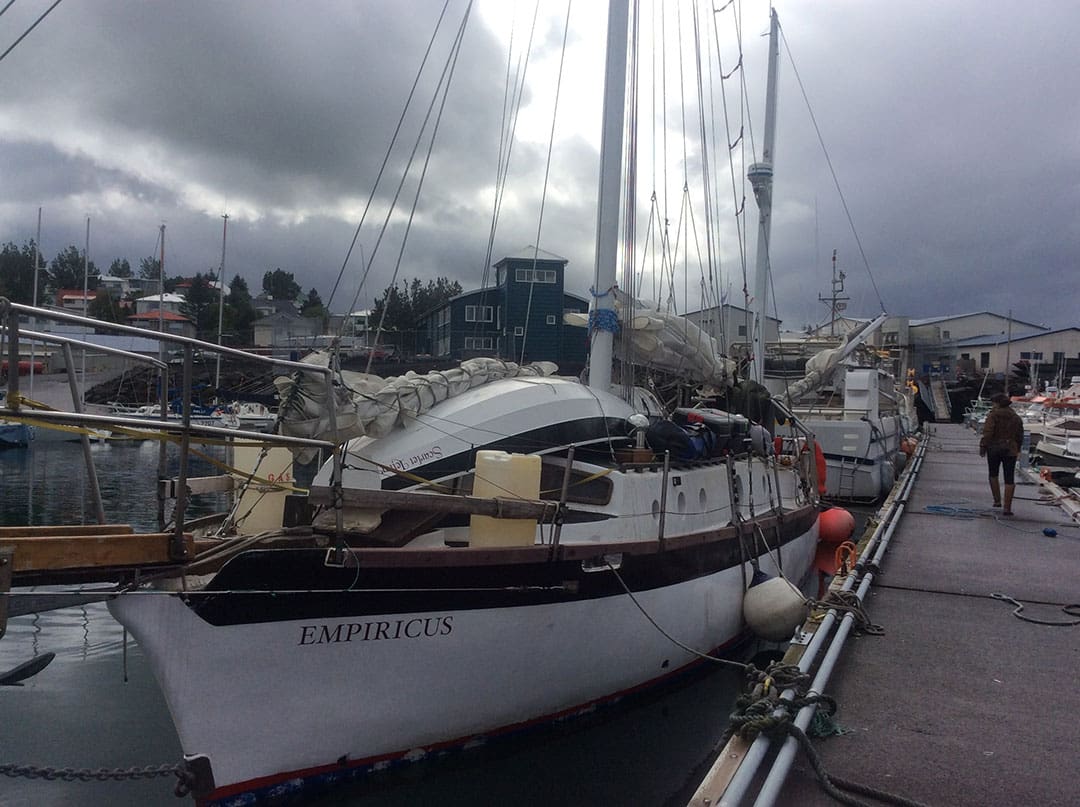
Our Icelandic Temporary Import Permit for the boat was set to expire, which meant either paying stiff import fees for the boat or departing Iceland. As my oldest son was graduating high school and the Alaska charter season was nearly upon us, I had only three weeks to prepare, splash and sail our 50-foot yawl, Empiricus, to Ireland. May was early, but that was our window. I hoped the winter storms were over.
Ordinarily, my wife and sailing partner Samantha would have made the passage with me, but she was back home, running our business in Alaska. She would instead provide weather information and remote support. I would be joined by two crew members, both of whom had sailed with me before. Both had struggled with seasickness.
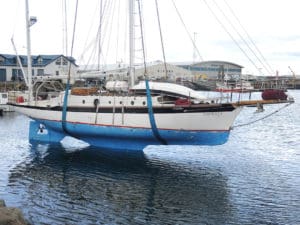
We all met in Hafnarfjordur Harbor, where the boat had overwintered on the hard. After a week of work, Empiricus was in the water. We had a good shakedown sail before departure.
On May 3, 17:27 GMT, we left Iceland just behind the tail of a decaying low, which gave us favorable winds.
We rounded the cape by nightfall and set course for the open sea, running with a double reefed main and a preventer. The ocean motion claimed one crew member to seasickness shortly after; he retired to his bunk, overcome by mal de mar.
At dawn, on our second day at sea, I was lurched from my bunk to the tell-tale feel of an accidental gybe. I sprang to the hatch and looked to port, where the main boom lay pinned against the running back-stay, as the helmsman explained how the wind had snatched the gaff. I twisted my torso to view an eye-bugging sight. The boom was broken at the preventer bail and nearly sheared in two.
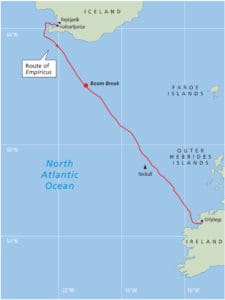
I fired up the engine and we headed to wind, for stowage of the main and damaged boom. Then I set the staysail and raised the mizzen while hardening both backstays. We bore away back on course and motor-sailed on, with 25 to 30 knots behind us. The sea was predicted to lay down later and then we would have an opportunity to work on the rig. I had 50 gallons of diesel in the main tank, 15 in the auxiliary and 25 on deck. Plenty of fuel for this passage.
I climbed back into my bunk to the Yanmar’s thrum and closed my eyes, now burning from fatigue. I was worried about the boom but also crewmember number two. He was bunk ridden and not improving as hoped. Iceland was now decidedly an upwind destination and we had no functioning mainsail. Nor could we motor against that sea. We were in no immediate danger — I would sleep on it.
Starved of fuel
About the time I relaxed enough to nod off, a loping engine rhythm perked my ears. It was the distinct sound of our diesel engine, starving for fuel. I was out of my bunk just as it died.
In my mind there was no way we were out of fuel, as we had run the engine very little. Just to be sure, I pulled the inspection hatch and dipped the tank. Bone dry! This seemed impossible — I had filled it to the brim before we left.
After inspecting all visible fuel lines and discussing the problem with my helmsman, a diesel mechanic by trade, I decided the most likely loss of fuel was a bad fuel lift pump diaphragm that was leaking. So, I bypassed the lift pump with an electric filtered pump unit I carried onboard, transferred five gallons to the primary tank, primed the system and started the engine.
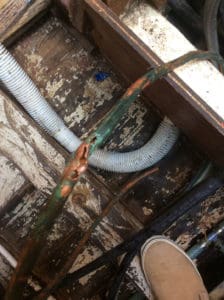
Next, I had to deal with the diesel-tinged water that now sloshed in the bilge. I wanted to get the job done quickly, so I laid out an emergency two-inch pump and fired up our little Honda generator right inside the boat (not recommended since the gas generator’s exhaust was a carbon monoxide danger, but I figured I could get it done fast enough so that it wouldn’t be a problem). I had roused seasick crewmember number two to man the helm while crewman number one and I problem solved. It was quite the sight: As the pump discharged diesel-smelling bilge water overboard, another stream of airborne muck came from the helmsman as he heaved from the helm.
I dismissed the miserable man and stowed the pump and secured the generator. After running briefly, the engine quit again, again depositing diesel in the bilge. We sailed on, while I took the helm and brainstormed the problem.
I envisioned each and every hose, fitting and pipe in the fuel system, while surfing down occasional very large waves and gleefully celebrating the lack of a lee shore. As forecast, the winds eased and the seas laid down somewhat. My steadiest crewmember relieved me at the helm. I went straight to work on the fuel system. I pumped the bilge again, primed the engine and got it running. This time, with all the floorboards up, I finally saw the source of the leak. A section of copper fuel line on the return side of the system was concealed from view where it passed through a wooden member. It had decayed in its tunnel and was leaking in a small, steady stream. It came apart with a tug and a brown rotten crust of copper revealed itself.
Fifteen minutes later, I had all new fuel line from the spares kit installed. To speed the repair, I set the fuel lines on the floorboards, not under them. The engine was now running well and we were back on the stock fuel pump to boot.
May 7 log entry (four days since departure): “0707, engine running well. Total fuel remaining = 10 gallons in aux tank, 25 gallons on deck. Fuel calculations based on 30 gallons usable = 60 hours at 1,500 rpm. (Approximately 300 miles on flat water), motor-sailing under mizzen, staysail and Yankee at 5.0 knots, winds eased and seas laying down. 350 miles to go.”
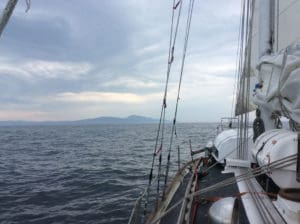
Weather on the way
I got some sleep finally after filling in Samantha using our Inreach communicator. I later awoke to her simple reply.
“You have weather coming.”
I groaned.
She continued. “You have a few hours before a very deep low passes over you. Expect strong northeast winds until the low goes past.” The low was moving slowly in a northerly direction, scouring the west coast of Ireland, reaching well out to sea. I noted my position — about 60 nautical miles northwest of Rockall Bank, a large area of shallow water with a single rock outcrop breaking the surface in the middle of the bank.
We would have cleared the obstacle of Rockall in mere hours on our current course. But with the gale imminent, Rockall Bank became a hazardous lee shore with tall waves and jagged rock. Without a main I could not hope to point up and round the bank on current course and heaving-to was out. The margin was too close for storm track assumptions.
I gave orders to turn north and burn fuel. Then I prepped the boat for heavy weather, by dousing and stowing the yankee, reefing the staysail, doubling the tack and clew with webbing and double strapping the hard tender with wetted lines. I shoved in earplugs and forced sleep, drifting off to a mental rehearsal of the seamanship I would require shortly.
The crew knew the plan: Handle her for as long as you can. Give up as little to the south as possible and wake me when the storm hits.
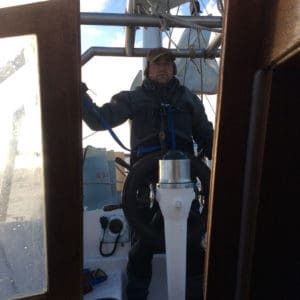
A sounding bell
They didn’t have to. The ship’s bell clattered like a one-room schoolhouse at lunchtime and water raced over the hull in loud, frothy surges. We were pinching, with engine assist, but making almost no speed.
I layered in wool before topping with my neoprene foul weather gear to take the helm. I snapped into two separate points with my harness, standard practice for me, no matter the weather. That habit ensures mobility skills and equipment familiarity when they are most needed.
With the engine off, I bore away to the east. The mizzen and staysail powered up, under hard sheets. I held all the speed I could, while the world around me transformed with the wind speed. I was already riding the biggest waves I had ever seen and began to appreciate that this was merely the beginning.
Empiricus is built with a bow like a splitting maul and a stern like a fantail. She has a three-inch nominal hull and is 18 inches thick at the bobstay fitting. She is nine feet wide, 42 feet on deck with a bulbous keel, cutaway forefoot and an oversized rudder. At 38,000 pounds, she is an ocean-crossing beast of a boat, and I took comfort in her stoutness in these hours.
At one point, early on, I got relief from the helm, to look in on our other crewmember. He was truly and utterly sick. He was also an EMT and was informing me between wretches what ingredients and elements would help him. I found a drink powder in the galley called “Alive”. No one liked it, but it was supposed to be a complete food. I tossed that over his lee cloth and explained to him that I was already doing everything I could for him at the helm. The explanation was interrupted by my other crewmember who said he could no longer tell which way was up or down and couldn’t steer any longer. And so, I left the cabin’s peaceful, surging capsule to take the helm again, this time for the duration.
After a few hours amongst a riot of marching waves, I decided to fire up the engine at a low rpm to give me steerage down in the troughs. Twice now, while trying to negotiate a position or avoid a breaker, we had been swamped, simply because I had no thrust in the windless valleys of the troughs. That trick worked and 1,000 rpm was sufficient to make the difference. The storm continued to grow. Wave heights easily topped my mast height.
It would start with water breaking over my head. Swinging from the left arm of my jack-line harness, which was snapped to the roll cage above, I held my breath and the wheel spokes while the weight of the sea rolled off my shoulders. As my head emerged from the boil, my eyes opened to the sting of salt. I spit ocean and scooped breath in gasps. Finding my hood with my left hand, I twisted it to block my face from the burn of high-speed droplets that filled the air like glass powder in a wind tunnel.
Through squinted eyes I watched the staysail rise out of the foam, under the influence of that powerful bulbous keel. This cascaded a great gob of sea from the staysail, which hammered the deck and rushed around the deck house. As the starboard side became visible, two great swirls in the cockpit confirmed both 5-inch scuppers were doing their job. The staysail now clear, the boat surged with unexpected power. It felt like 1,000 horsepower strapped to the foredeck. Empiricus leapt from the boil to glide over the next crest moments later, running fast like a dirt bike on the ridge of a sand dune.
Against a glistening green wall of sea, I would flick the helm and dive again into the next trough. The monster breakers simply hammered us flat like a bent nail, then buried us under. Scooping a breath before the rig smacked down, the whole process would begin again. And again, and again.
The power in the sea, the wind, the staysail, and keel was fantastic. The wave faces were longer than the boat, making them more than 50 feet high.
I was strapped to a titan’s grudge match, between Empiricus, who seemed ordered by the Almighty to drag me bodily through this war zone, and the sea. Each plunging yank of the harness signaled “Get up,” and “Stay with me.”
Clawing east
The storm track headed more west than north, which gave me no relief from Rockall. So, I clawed east like that until 0200 on the 8th, having made enough easting to bear south a bit.
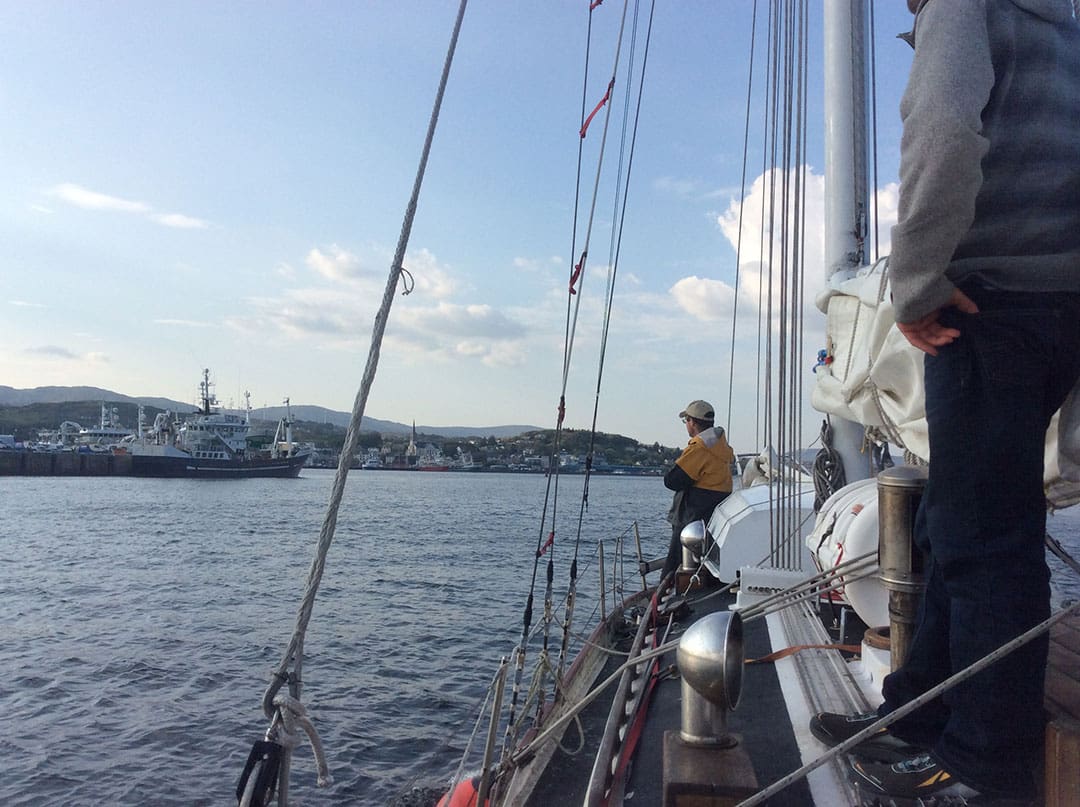
By 1830 that night the storm had eased to merely a gale and I killed the engine to save fuel. By 0200 on the 9th, I was motor-sailing again, in light air, over a long, smooth lump, 175 NM from Ireland.
By 0300 I was below, doffing gear. My layers of wool, long johns and underwear had been stripped down from my hips and thighs. I was naked under neoprene from hips to calves and my suspenders stretched under the soggy wool now packed into my boots. I walked with a shuffle to my bunk, sloshing water everywhere. I stripped down, tipped into my sleeping bag and passed out. Nothing I owned was dry and everything smelled of vomit and diesel. When I returned to the helm at 1400, I was a naked man, wrapped in a partially soaked army surplus sleeping bag, face set like a flint for Ireland. My clothes decorated the cockpit. We were like a slow parade of only one float, without the flying candy but all the smiles.
I set the Yankee for some speed at first light and kept the motor spinning. We sighted land at noon on the 10th and entered Donegal Bay near 1600. By 1900, we were at the dock at Killybegs, with no injuries, no further damage and 15 gallons of fuel. Immediately we sought Guinness and red meat, with the hearty approval of customs.
The lessons I learned were many I and am still friends with those crew members. Hell, I love those guys. But I should have brought Samantha, or just paid the taxes. n
Jesse Osborn owns Seven Seas Sailing Logistics, which provides captain services, consulting, teaching and project management for sailboats.

